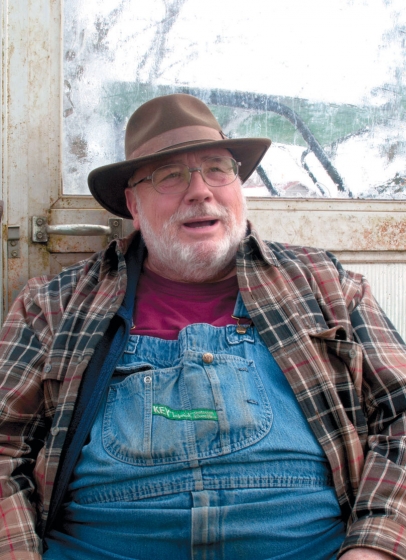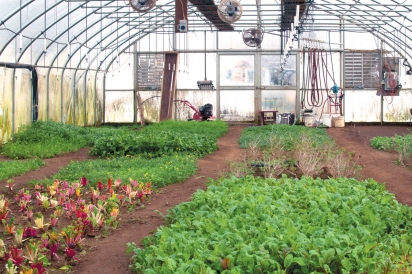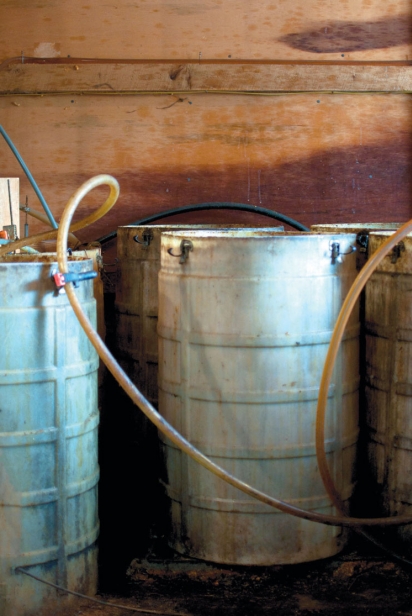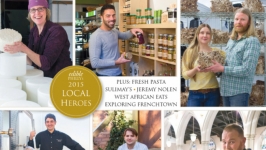Green Meadow Farm, From Fryer to Fire
Green Meadow Farm powers through the winter on an unlikely energy source
Locally grown bananas may seem an unusual thing to encounter in Philadelphia, especially in November, but that’s exactly what you’ll find in the Green Meadow Farm greenhouses. What’s more surprising than the existence of the bananas—and the blood oranges and tangerines—is the way Glenn Brendle and his son, Ian, keep these greenhouses warm all winter long. Their secret? Vegetable oil.
Glenn Brendle grew up on a farm in Lancaster County. He went away to Penn State, where he earned a degree in electrical engineering, and then worked for RCA for a few years. “I tried a lot of different things; I even got into advertising for a while,” he says, “I didn’t like any of it very much.”
All the while, Brendle and his wife Karen had a small farm. On weekends Brendle was taking an Amish friend to the Reading Terminal Market to sell produce. Eventually Brendle started adding his own wares to the stand and made his first connections with Philadelphia chefs.
“[The chefs] said they would buy stuff except they didn’t want to have to carry it back to the restaurant,” explains Brendle. “So I said, ‘Well, what if I deliver it?’ “ Brendle began with a small pushcart and walked orders to customers located within a few blocks of the market. Eventually the pushcart turned into a truck, and the small farm was traded for a bigger one in nearby Gap, Pennsylvania. “It just kept going and we never looked back.”
Today, nearly 30 years later, Glenn and Ian Brendle grow crops on about 10 acres and in three greenhouses. They also contract with 10 to 15 other farmers who grow things Green Meadow doesn’t have space for, especially vine crops, such as squashes, zucchinis and melons, which take up a lot of acreage. “Whether it’s stuff we grow here or someone else is growing for us, it’s all picked to order,” explains Ian. Once a week, they drive to Philadelphia and deliver to chefs including Michael Solomonov.
Early on Brendle discovered that while farming was seasonal, selling to chefs was a year-round gig. The first couple of years he didn’t have anything to offer in the wintertime and had to temporarily shut down. “Then in the spring you try and get your customers back and they forget who you were,” he says. Brendle realized he needed to be there every week if he wanted to build reliable relationships.
He put up some small greenhouses, but hit another roadblock: heating costs. Keeping greenhouses warm through the cold season can be expensive, which means higher prices for produce. Unheated high tunnels—simpler versions of greenhouses—were a risky option, so Brendle started experimenting with alternative fuels.
One day Brendle was at Monk’s Café on a delivery and noticed jugs of used vegetable oil piled in the narrow alleyway leading to the kitchen. The resale value of oil was low at the time and the rendering company that usually picks up the jugs was in no hurry to get the oil, leaving it sitting there for a while. So, owner Tom Peters offered the batch to Brendle for free.
Over the next year Brendle put his electrical engineering degree to use. The result was a system similar to what garages use to burn waste oil from cars. “We’ve been tweaking it and adjusting it ever since,” he says, “and I think we got it down.”
The system relies on the 300 to 350 gallons picked up each Friday from nearly two dozen Philadelphia restaurants, including American Sardine Bar, Jack’s Firehouse and Tattooed Mom. Although locations vary each week depending on what’s available, “consistency is what helps us,” says Ian. While Green Meadow doesn’t pay for the oil, they make pickups every week, something big rendering companies don’t guarantee.
Back at the farm, the oil is dumped into large barrels so any leftover breading can settle to the bottom. The detritus becomes a tar, which can be used for paving. “It’s actually a lot less impactful than [asphalt] because it’s not a petroleum product,” says Brendle, who happily shared the tar with neighbors as well as using it on his own farm for road repairs.
Once clarified, the waste oil is pumped into the firebox and essentially becomes a grease fire, generating enough energy to heat three greenhouses and Brendle’s home. The system, which sits in a small shed next to the house, also gives off enough warmth to dry herbs and vegetables like tomatoes and peppers.
“The first investment was about $10,000 to $15,000, but that was recouped in probably a year,” says Brendle. Regular petroleum-based heating oil prices currently hover at around $3 a gallon, but Brendle pays nothing for vegetable oil. Green Meadow uses about 10,000 gallons annually, which adds up to $30,000 in savings.
Saving money isn’t Brendle’s only motivation for using vegetable oil. Green Meadow follows what it calls “minimum input farming.” The goal is to have as small an environmental footprint as possible. This means using commercial pesticides sparingly and enriching the soil with compost—some of which is made from Philadelphia restaurant food waste. Heating with vegetable oil has become another way to further that mission.
“As a farmer you’re a steward of the land, [and] while we own it, [the land] is still part of the Earth,” says Ian. “My dad realized that heating with vegetable oil was going to take a product out of the waste system. I think that was pretty cool.”
GREEN MEADOW FARM
130 S. Mount Vernon Rd., Gap
717.442.5222








